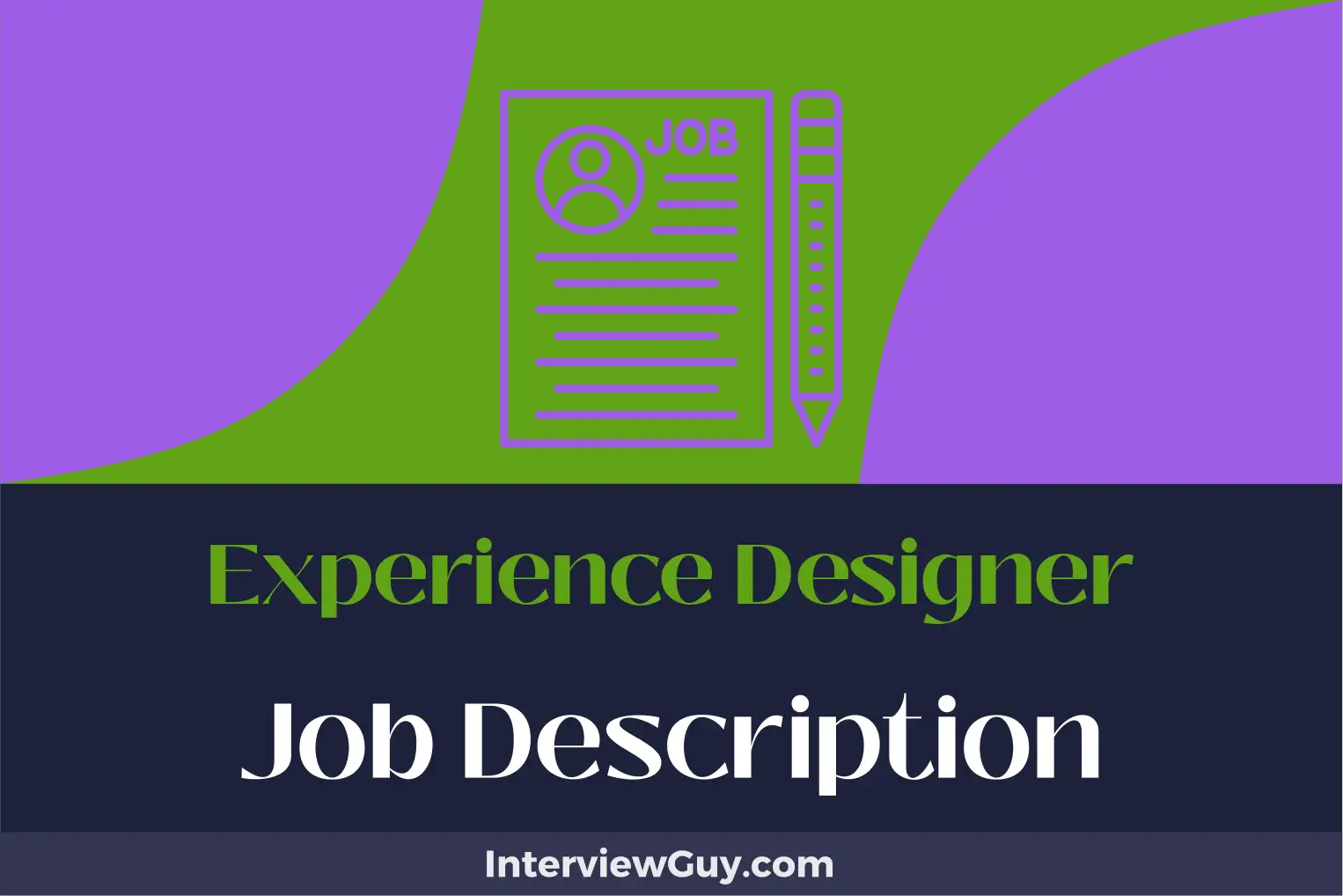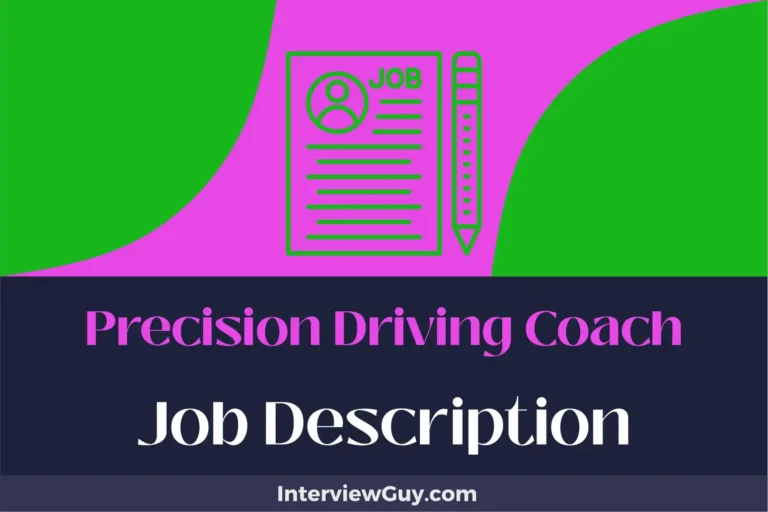Experience Designer Job Description [Updated for 2025]

In the era of user-centric design, the importance of experience designers has never been greater.
As our digital landscape evolves, the demand for creative thinkers who can craft, refine, and enhance our user experience continues to grow.
But let’s delve deeper: What’s really required of an experience designer?
Whether you are:
- A job seeker seeking to understand the core of this role,
- A hiring manager outlining the perfect candidate,
- Or simply fascinated by the realm of experience design,
You’ve come to the right place.
Today, we present a customizable experience designer job description template, designed for effortless posting on job boards or career sites.
Let’s dive right into it.
Experience Designer Duties and Responsibilities
Experience Designers are professionals who focus on the quality of interactions and experiences users have with a company’s products or services.
They use design thinking to understand users’ needs, make their experience more engaging, intuitive, and satisfying.
Their key duties and responsibilities often include:
- Research and analyze user behavior and needs
- Design, plan, and implement user interaction models and interfaces
- Create and test interactive prototypes to iterate and refine designs
- Collaborate with cross-functional teams like product management, engineering, and marketing to integrate user-centered design processes
- Present and communicate design approaches and insights to stakeholders
- Evaluate the effectiveness of designs using user feedback and usability testing
- Stay current with technology and design trends to maintain modern design solutions
- Document design processes and user interfaces for reference and team communication
Experience Designer Job Description Template
Job Brief
We are seeking a talented Experience Designer to conceptualize and implement engaging user experiences across our digital platforms.
The responsibilities of the Experience Designer include gathering user requirements, designing graphic elements and building navigation components, as well as creating both functional and appealing features that address our users’ needs and help us grow our customer base.
The ideal candidate should have experience with design software and wireframe tools.
If you also have a portfolio of professional design projects that includes work with web/mobile applications, we’d like to meet you.
Responsibilities
- Gather and evaluate user requirements in collaboration with product managers and engineers
- Conceptualize original ideas that bring simplicity and user friendliness to complex design roadblocks
- Create wireframes, storyboards, user flows, process flows and site maps to effectively communicate interaction and design ideas
- Establish and promote design guidelines, best practices and standards
- Present and defend designs and key milestone deliverables to peers and executive level stakeholders
- Conduct user research and evaluate user feedback
- Execute all visual design stages from concept to final hand-off to engineering
Qualifications
- Proven work experience as an Experience Designer, UI/UX Designer or similar role
- Portfolio of design projects
- Knowledge of wireframe tools (e.g. Wireframe.cc and InVision)
- Up-to-date knowledge of design software like Adobe Illustrator and Photoshop
- Team spirit; strong communication skills to collaborate with various stakeholders
- Good time-management skills
- BSc in Design, Computer Science or relevant field
Benefits
- 401(k)
- Health insurance
- Dental insurance
- Retirement plan
- Paid time off
- Professional development opportunities
Additional Information
- Job Title: Experience Designer
- Work Environment: Office setting with options for remote work. Some travel may be required for team meetings or client consultations.
- Reporting Structure: Reports to the Lead Designer or Design Manager.
- Salary: Salary is based upon candidate experience and qualifications, as well as market and business considerations.
- Pay Range: $85,000 minimum to $135,000 maximum
- Location: [City, State] (specify the location or indicate if remote)
- Employment Type: Full-time
- Equal Opportunity Statement: We are an equal opportunity employer and value diversity at our company. We do not discriminate on the basis of race, religion, color, national origin, gender, sexual orientation, age, marital status, veteran status, or disability status.
- Application Instructions: Please submit your resume, portfolio, and a cover letter outlining your qualifications and experience to [email address or application portal].
What Does an Experience Designer Do?
Experience Designers, also known as User Experience (UX) Designers, primarily work for tech companies, advertising agencies, and design consultancies.
They may also work as freelance consultants.
Their main job is to improve the quality of a user’s interaction with a product or service.
This involves understanding and addressing user needs and expectations.
They achieve this by designing the overall flow and functionality of a product or service, making it intuitive and easy to use for the end user.
Experience Designers conduct user research to understand the needs, motivations, and behaviors of users.
They create personas, user flows, wireframes, and prototypes to test and validate their designs.
They also use various tools and software to create and implement their designs.
They work closely with other team members, including product managers, software engineers, and graphic designers, to integrate the visual, interactive, and industrial aspects of a user experience into one cohesive approach.
Their role also involves continually testing and refining their designs based on user feedback and new research findings, ensuring that the user experience is always optimized.
They may also be involved in creating content and strategies for digital marketing efforts.
Ultimately, the goal of an Experience Designer is to create a seamless, enjoyable, and efficient user experience that fulfills the business objectives while satisfying the user’s needs and expectations.
Experience Designer Qualifications and Skills
Experience Designers are responsible for designing products, processes, services, events, and environments with a focus on the quality of user experience.
They need a range of technical, creative, and interpersonal skills, including:
- Proficiency in software related to user experience design, such as Adobe Creative Suite, Sketch, or Invision, to create visually engaging and functional designs.
- Strong understanding of user-centered design principles to ensure that design decisions are guided by the needs and experiences of users.
- Excellent communication skills for collaborating with clients, team members, and stakeholders, as well as for presenting design ideas and research findings.
- Research and analytical skills to understand user behavior, needs, and motivations, and to evaluate the effectiveness of design solutions.
- Creativity and problem-solving skills to innovate and design compelling user experiences that meet both user needs and business goals.
- Experience in conducting user testing and usability studies to inform design decisions and improve the overall user experience.
- Understanding of web development languages such as HTML, CSS, and JavaScript, to better collaborate with developers and create realistic designs.
- Project management skills for overseeing multiple projects at once, meeting deadlines, and prioritizing tasks effectively.
Experience Designer Experience Requirements
Entry-level Experience Designers may have 1 to 2 years of relevant experience, often gained through internships or part-time roles in the field.
These professionals can also gain on-the-job experience in roles such as User Researcher, User Interface Designer, or other creative roles related to the design of user experiences.
Candidates with more than 3 years of experience often have a well-rounded portfolio of user experience projects, where they have demonstrated their ability to combine creativity, research, and technology to create a seamless user experience.
At this point, they usually have a deep understanding of design principles and a clear grasp of the latest design trends and tools.
Those with more than 5 years of experience often have a history of leading projects or teams, and thus may be ready for a senior or managerial role.
This can also include experience in cross-functional collaboration, strategic thinking, and the ability to influence the design culture within a company.
In addition to the duration of their experience, Experience Designers often need to have hands-on experience with various design software, the ability to conduct and analyze user research, and the capacity to translate findings into design solutions.
They should also have a good understanding of web development and coding.
Experience Designer Education and Training Requirements
Experience Designers usually have a bachelor’s degree in design, psychology, marketing, computer science or another related field.
They also need a solid understanding of user experience (UX) principles and strong visual design skills.
Knowledge of design software like Adobe Creative Suite is essential.
Many Experience Designers also have a background in research, allowing them to better understand user needs and behaviors.
For more advanced roles, a master’s degree in interaction design, human-computer interaction, or a similar field can be beneficial.
Certification from a recognized design organization, such as the Interaction Design Foundation, can also be a plus.
Proficiency in coding languages like HTML, CSS, and JavaScript can be an advantage, although not strictly necessary for all roles.
Continued education, whether through formal courses or self-study, is important in this rapidly evolving field to keep up with new tools and methodologies.
Experience Designer Salary Expectations
An Experience Designer can expect to earn an average salary of $85,277 (USD) per year.
However, the actual income can fluctuate based on factors such as professional experience, educational background, and the location of the job.
Experience Designer Job Description FAQs
What skills does an Experience Designer need?
Experience Designers need a diverse skill set that includes excellent problem-solving skills, creativity, and a strong understanding of user behavior.
They need to be adept at digital tools like Adobe Creative Suite and Sketch, as well as prototyping tools such as InVision or Figma.
Good understanding of data analysis, user research, and project management are also necessary.
Do Experience Designers need a degree?
While a degree isn’t always necessary, many Experience Designers have degrees in fields like interaction design, graphic design, industrial design, or a related field.
However, practical experience, a robust portfolio, and a demonstrated understanding of user experience principles can often compensate for a lack of formal education.
What should you look for in an Experience Designer’s resume?
An Experience Designer’s resume should showcase a solid understanding of user experience design principles and processes.
Look for experience in conducting user research, developing user personas, wireframing, prototyping, and usability testing.
A strong portfolio of previous work showing their design process from concept to final product is also essential.
What qualities make a good Experience Designer?
A good Experience Designer is empathetic and user-focused, always striving to understand the needs and wants of the user.
They are analytical, using data and research to inform their designs.
Creativity and problem-solving skills are also crucial as they need to design solutions that are not only functional and user-friendly but also aesthetically pleasing.
What is the difference between an Experience Designer and a User Interface (UI) Designer?
While there is some overlap, Experience Designers primarily focus on the overall experience a user has with a product or service, while UI Designers focus specifically on the visual elements of a product’s interface.
Experience Designers often need to consider a broader range of factors, including user emotions and long-term user engagement, while UI Designers are concerned with ensuring the product is visually cohesive and intuitive to use.
Conclusion
There we have it.
Today, we’ve explored the intriguing world of an experience designer.
Surprised?
It’s not all about creating user interfaces.
It’s about designing meaningful and relevant experiences, one interaction at a time.
Armed with our ready-to-use experience designer job description template and real-world examples, you’re ready to take the next step.
But don’t stop yet.
Go further with our job description generator. It’s your tool for creating finely tailored listings or perfecting your resume.
Remember:
Every interaction contributes to the overall user experience.
Let’s design that future. Together.
How to Become an Experience Designer (Complete Guide)
Satisfying Career Quests: The Most Fulfilling Jobs to Pursue
Tales from the Edge: Personal Stories from High-Risk Jobs


![Corporate Security Manager Job Description [Updated for 2025]](https://interviewguy.com/wp-content/uploads/2024/05/corporate-security-manager-job-description-768x512.webp)


![Steel Fixer Job Description [Updated for 2025]](https://interviewguy.com/wp-content/uploads/2024/02/steel-fixer-job-description-768x512.webp)
![Facilities Manager Job Description [Updated for 2025]](https://interviewguy.com/wp-content/uploads/2024/02/facilities-manager-job-description-768x512.webp)